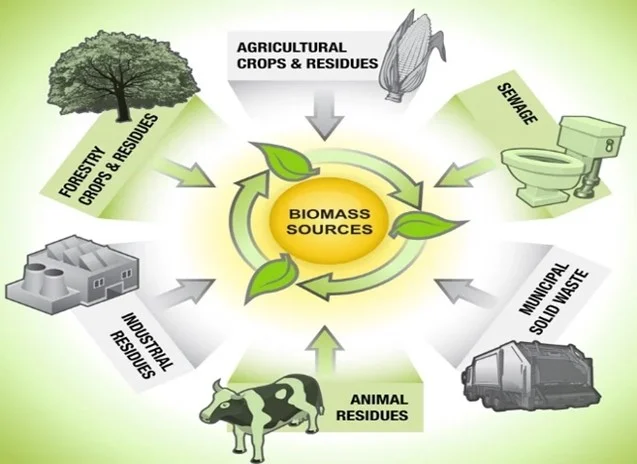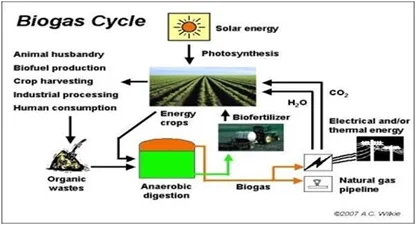Environment & Ecology
Context: Recently, the Ministry of New and Renewable Energy organized a seminar on the National Bio Energy Programme in New Delhi in partnership with UNIDO and GEF as part of Azadi Ka Amrit Mahotsav along with launching of Biourja and Biogas portals.
- BioUrja portal has been developed as a single window platform to register and submit online applications for grant of Central Financial Assistance (CFA) to Waste to Energy projects, Biomass Briquette/Pellet manufacturing plants and Biomass (non-bagasse) based cogeneration projects.
- Biogas portal provides an overview on biogas related information.
About Biomass:

- Biomass has always been an important energy source for the country considering the benefits it offers.
- It is renewable, widely available, carbon-neutral and has the potential to provide significant employment in the rural areas.
- Biomass is also capable of providing firm energy.
- Biomass materials used for power generation include bagasse, rice husk, straw, cotton stalk, coconut shells, soya husk, de-oiled cakes, coffee waste, jute wastes, groundnut shells, saw dust etc.
Potential of Biomass:
- As per a recent study sponsored by MNRE, the current availability of biomass in India is estimated at about 750 million metric tonnes per year.
- The Study indicated estimated surplus biomass availability at about 230 million metric tonnes per annum covering agricultural residues corresponding to a potential of about 28 GW.
- This apart, about 14 GW additional power could be generated through bagasse based cogeneration in the country’s 550 Sugar mills, if these sugar mills were to adopt technically and economically optimal levels of cogeneration for extracting power from the bagasse produced by them.
About National Bioenergy Programme:
- The Ministry of New and Renewable Energy has notified the National Bioenergy Programme in November 2022.
- MNRE has continued the National Bioenergy Programme for the period from FY 2021-22 to 2025-26.
- The Programme has been recommended for implementation in two Phases:
- The Phase-I of the Programme has been approved with a budget outlay of Rs. 858 crores.
- It will comprise the following sub-schemes:
- Waste to Energy Programme:
- It is programme on Energy from Urban, Industrial and Agricultural Wastes /Residues to support the setting up of large Biogas, BioCNG and Power plants.
- Indian Renewable Energy Development Agency (IREDA) will be the implementing agency for the program.
- Biomass Programme:
- It is a Scheme to Support Manufacturing of Briquettes & Pellets and Promotion of Biomass (non-bagasse) based cogeneration in Industries to support setting up of pellets and briquettes for use in power generation and non-bagasse based power generation projects.
- Biogas Programme:
- To support setting up of family and medium size Biogas in rural areas.

Significance of Bioenergy:
- Organic enriched Bio-manure: The digested slurry from biogas plants is a rich source of manure which shall benefit farmers in supplementing / reducing the use of chemical fertilizers.
- It is carbon neutral: As a natural part of photosynthesis, biomass fuels only release the same amount of carbon into the atmosphere as was absorbed by plants in the course of their life cycle.
- It reduces the overreliance of fossil fuels: Not only is there a limited supply of fossil fuels, but fossil fuels come with environmental baggage, including the release of large amounts of carbon dioxide into the atmosphere and the pollutants that result from removal, transportation and production.
- Less expensive than fossil fuels: While fossil fuel production requires a heavy outlay of capital, such as oil drills, gas pipelines and fuel collection, biomass technology is much cheaper. Manufacturers and producers are able to generate higher profits from a lower output.
- It helps in providing clean cooking through biogas.
- Co-firing in thermal power plants by utilizing biomass pellets and briquettes and BioCNG for transport.
- Setting up of biogas plants for clean cooking fuel, lighting, meeting thermal and small power needs of users which results in GHG reduction, improved sanitation, women empowerment and creation of rural employment.
Challenges before Bioenergy:
- Can lead to deforestation: Since wood is one of the most used sources of biomass energy, vast amounts of wood and other waste products have to be burned to produce the desired amount of power.
- While currently there is enough wood waste already, there is a risk of deforestation in the future.
- Biomass energy is not as efficient as fossil fuels: Some biofuels, like Ethanol, are relatively inefficient as compared to gasoline. In fact, it has to be fortified with fossil fuels to increase its efficiency.
- It is not entirely clear: While biomass is carbon neutral, the use of animal and human waste escalates the amount of methane gases, which are also damaging to the environment.
- Additionally, the pollution created from burning wood and other natural materials can be considered just as bad as that resulting from burning coal and other types of energy resources.
- Biomass construction plants don’t come cheap: The harvest, transportation and storage of organic matter can be costly and go beyond what other renewable sources need such as solar power.
Way Forward:
- India is capable of generating over 750 million metric tonnes of biomass each year, creating a huge potential for the generation of bioenergy.
- The Ministry of New and Renewable Energy has been promoting bioenergy in India since the 1980s to make use of the surplus biomass, cattle dung, industrial and urban biowaste that are generated within the country.
- The benefits of utilization of surplus biomass should reach the rural household by way of an additional source of income for farmers.
- The extra push in the form of a 20 per cent higher standard CFA (central financial assistance) pattern for the north-eastern region and Gaushala/shelter was the need of the time to create inclusiveness in an applied manner.
Thus, as a whole it will also support to national commitments in achieving climate change goals, along with reduction in import of natural gas and crude oil and buffer against crude oil/gas price fluctuations.
Source: PIB
Previous Year Questions
Q.1) “Biorock technology” is talked about in which one of the following situations?
- Restoration of damaged coral reefs
- Development of building materials using plant residues
- Identification of areas for exploration/extraction of shale gas
- Providing salt licks for wild animals in forests/protected areas
Q.2) According to India’s National Policy on Biofuels, which of the following can be used as
raw materials for the production of biofuels? (2020)
- Cassava
- Damaged wheat grains
- Groundnut seeds
- Horse gram
- Rotten potatoes
- Sugar beet
Select the correct answer using the code given below:
- 1, 2, 5 and 6 only
- 1, 3, 4 and 6 only
- 2, 3, 4 and 5 only
- 1, 2, 3, 4, 5 and 6













